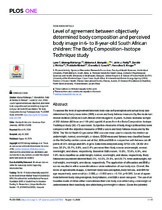Level of agreement between objectively determined body composition and perceived body image in 6- To 8-year-old South African children- To Body Composition-Isotope Technique study

View/
Date
2020Author
Mchiza, Zandile J.
Moeng-Mahlangu, Lynn T.
Monyeki, Makama Andries
Reilly, John J.
Metadata
Show full item recordAbstract
To assess the level of agreement between body size self-perception and actual body size determined by body mass index (BMI) z-score and body fatness measured by the deuterium dilution method (DDM) in South African children aged 6-8 years. A cross-sectional sample of 202 children (83 boys and 119 girls) aged 6-8 years from the Body Composition-Isotope Technique study (BC-IT) was taken. Subjective measures of body image (silhouettes) were compared with the objective measures of BMI z-score and body fatness measured by the DDM. The World Health Organization BMI z-scores were used to classify the children as underweight, normal, overweight, or obese. DDM-measured fatness was classified based on the McCarthy centile curves set at 2nd, 85th and 95th in conjunction with fatness cut-off points of 25% in boys and 30% in girls. Data were analyzed using SPSS v26. Of 202 children, 32.2%, 55.1%, 8.8%, and 2.4% perceived their body size as underweight, normal, overweight, and obese, respectively. Based on BMI z-score, 18.8%, 72.8%, 6.9%, and 1.5% were classified as underweight, normal, overweight, and obese, respectively. Body fatness measurement showed that 2.5%, 48.0%, 21.8%, and 29.7% were underweight, normal weight, overweight, and obese, respectively.
